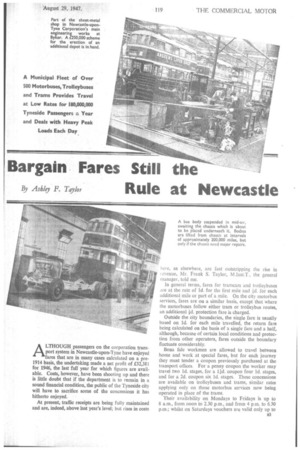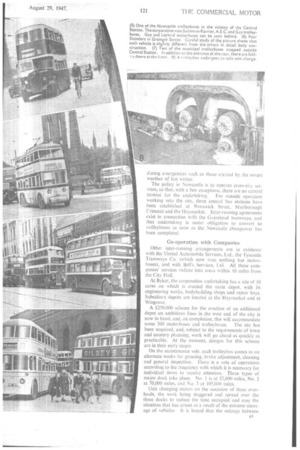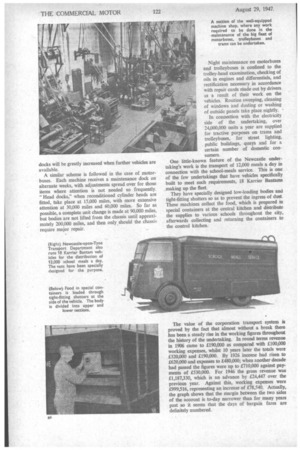Bargain Fares Still the
Page 37

Page 38

Page 39

Page 40

If you've noticed an error in this article please click here to report it so we can fix it.
By Ashley F. Taylot Rule at Newcastle ALTHOUGH passengers on the corporation transport system in Newcastle-upon-Tyne have enjoyed fares that are in many cases calculated on a pre1914 basis, the undertaking made a net profit of £32,381 for 1946, the last full year for which figures are available. Costs, however, have been shooting up and there is little doubt that if the department is to remain in a sound financial condition, the public of the Tyneside city will have to sacrifice some of the concessions it has hitherto enjoyed.
At present, traffic receipts are being fully maintained and are, indeed, above last year's level; but rises in costs gere, as elsewhere, are fast outstripping the rise in revenue, Mr. Frank S. Taylor, M.I.nst.T., the general manager, told me.
In general terms, fares for tramcars and trolleybuses are at the rate of id. for the first mile and id. for each additional mile or part of a mile. On the city motorbus services, fares are on a similar basis, except that where the motorbuses follow either tram or trolleybus routes, an additional id. protection fare is charged.
Outside the city boundaries, the single fare is usually based on id. for each mile travelled, the return fare being calculated on the basis of a single fare and a half, although, because of certain local conditions and protection from other operators, fares outside the boundary fluctuate considerably.
Bona fide workmen are allowed to travel between home and work at special fares, but for each journey they must tender a coupon previously purchased at the transport offices. For a penny coupon the worker may travel two Id. stages, for a lid, coupon four id. stages, and for a 2d. coupon six Id. stages. These concessions are available on trolleyb uses and trams, similar rates applying only on those motorbus services now being operated in place of the trams. Their availability on Mondays to Fridays is up to 8 a.m., from noon to 2.30 p.m., and from 4 p.m. to 6.30 p.m.; whilst on Saturdays vouchers are valid only up to 93 8 a.m. and between 11.30 a.m. and 1.30 p.m. City terminal tickets costing only id. are used in the city centre.
Newcastle-upon-Tyne transport and electricity undertaking was founded in 1901. Before that date a private operator worked a horsed-tram system, the corporation leasing the lines to the company.
From the time of the changeover, the city gradually developed its tram system, progress proceeding right up to 1923-24, when the last major tramway extension was made. This was the crossing of the Tyne bridges, with a view to starting inter-running with the Gateshead trams; the same period saw the introduction of a new light railway through Gosforth Park.
Bus Powers Granted in 1911 First powers to run motorbuses were obtained under an Act of 1911, which provided for services to the small outlying area of Westerhope. Things stood still throughout the 1914-18 war, but in 1922 powers were obtained to run in Northumberland. Five years later a further Act provided for the introduction of buses on certain tram routes.
From that date, corporation bus services started to develop, especially in areas adjacent to the city. In 1934-35, the corporation embarked upon the policy of substituting trolleybuses for trams. The undertaking possessed its own power station and had always been able to generate electrical energy cheaply, as a result of which it was possible to enter into an advantageous contract with the Central Electricity Board.
Conversion began in 1935, and, by the outbreak of war, approximately 50 per cent, of the tram routes had been changed over to trolleybus operation. Once again the war years were a blank. Work came to a stop and, at the same time, the permanent way ceased to receive its normal attention. Tracks are now suffering from deferred maintenance and the need for renewals, but the committee is going ahead as quickly as possible with the policy of converting the remainder of the routes.
Next group to go over will be the Great North Road services. This conversion should have been completed by spring of this year, but was obstructed by difficulty in obtaining delivery of trolleybuses.
At the present the fleet consists of 506 machines, made up of 137 trolleybuses, 167 motorbuses and 202 trams. a4 Chief motorbus types in current use are Daimler and A.E.C., but a substantial order has also been given fat Leylands. On the trolleybus side, makes employed are Sunbeam-Karrier, A.E.C. and Guy, whilst orders have also been given for the new B.U.T. chassis. Bodywork is mainly by Chas. H. Roe, Ltd., Park Royal Vehicles, Ltd., Northern Coachbuilders, -Ltd., and MetropolitanCammell-Weymann Motor Bodies, Ltd.
Buses are usually of 56-seater capacity, although trolleybuses ordered before the war were of the 30-ft. three-axled type, with front and rear entrances and poweroperated doors, and seated 60 persons. Types now on order, however, will employ a similar chassis, but have only rear entrances, and provide seating for 70 people. The specification for the 36 new trolleybuses to be employed on the North Road extension indicates that these machines will be of 8-ft. width.
Passengers Increase by 50 Per Cent.
The number of passengers carried by the department has increased by over 50 per cent. since before the war, the annual total now being approximately 180,000,000, which means that about 500,000 tickets are issued each day in a citywith a total population of approximately 300,000. Particularly in the centre of the city, conductors have an extremely busy time, and the management now proposes to give a thorough trial to the Bell Punch Ultamate Auto Fare collector, and 500 machines of this kind have been ordered.
Incidentally, the system is subject to especially heavy peak loading from the riverside, coincident with the city business-area peak. Every effort is made to provide passenger shelters at heavy loading points and exposed places, and numerous additions to those covered barriers are constantly being made.
At the present time, employees of the undertaking number nearly 3,000. An interesting feature of the welfare side of the organization is the existence of a noncontributory pension scheme. This provides that every man who retires on grounds of age or permanent illhealth, after not less than 15 years on the staff, receives a weekly allowance of 6d. for each year of service, with a maximum of £1.
A welcome amenity for the traffic staff is the mobile canteen, which has proved itself invaluable, especially
during emergencies such as those created by the severe weather of last winter.
The policy in Newcastle is to operate cross-city services, so that, with a few exceptions, there are no central
termini for the undertaking. For outside operators working into the city, three central bus stations have been established at Worswick Street, Marlborough Crescent and the ilaymarket. Inter-running agreements exist in connection with the Gateshead tramways, and that undertaking is under obligation to convert to irolleybuses as soon as the Newcastle changeover has been completed.
Co-operation with Companies Other inter-running arrangements are in existence with the United Automobile Services, Ltd., the Tyneside Tramways Co. (which now runs nothing but motorbuses), and with Bell's Services, Ltd. All these companies' services radiate into areas within 10 miles from the City Hall.
At Byker, the corporation undertaking has a site of 10 acres on which is erected the main depot, with its engineering works, bodybuilding shops and repair bays. Subsidiary depots are located at the Haymarket and at Wingrove.
A £250,000 scheme for the erection of an additional depot on ambitious lines in the west end of the city is now in hand, and, on completion, this will accommodate some 300 motorbuses and trolleybuses. The site has been acquired, and, subject to the requirements of town and country planning, work will go ahead as quickly as practicable. At the moment, designs for this scheme arc in their early stages.
On the maintenance side, each trolleybus comes in on alternate weeks for greasing, brake adjustment, cleaning and general inspection. There is a rota of operations according to the frequency with which it is necessary for individual items to receive attention. Three types of major dock take place. No. 1 is at 35,000 miles, No. 2 at 70,000 miles, and No. 3 at 105,000 miles.
Unit changing occurs on the occasion of these overhauls, the work being staggered and spread over the three docks to reduce the time occupied and ease the situation that has arisen as a result of the extreme shortage of vehicles. It is hoped that the mileage between docks will be greatly increased when further vehicles are available.
A similar scheme is followed in the case of motorbuses. Each machine receives a maintenance dock on alternate weeks, with adjustments spread over for those items where attention is not needed so frequently. "Head docks," when reconditioned cylinder heads are fitted, take place at 15,000 miles, with more extensive attention at 30,000 miles and 60,000 miles. So far as possible, a complete unit change is made at 90,000 miles, but bodies are not lifted from the chassis until approximately 200,000 miles, and then only should the chassis require major repair. Night maintenance on motorbuses and trolleybuses is confined to the trolley-head examination, checking of oils in engines and differentials, and rectification necessary in accordance with repair cards made out by drivers as a result of their work on the vehicles. Routine sweeping, cleaning of windows and dusting or washing of outside panels take place nightly.
In connection with the electricity side of the undertaking, over 24,000,000 units a year are supplied for tractive purposes on trams and trolleyb uses, for street lighting, public buildings, quays and for a certain number of domestic consumers.
One little-known feature of the Newcastle undertaking's work is the transport of 12,000 meals a day in connection with the school-meals service. This is one of the few undertakings that have vehicles specifically built to meet such requirements, 18 Karrier Bantams _ making up the fleet.
They have specially designed low-loading bodies and tight-fitting shutters so as to prevent the ingress of dust, These machines collect the food, which is prepared in special containers at the central kitchen and distribute the supplies to various schools throughout the city, afterwards collecting and returning the containers to the control kitchen.
The value of the corporation transport system is proved by the fact that almost without a break there has been a steady rise in the working figures throughout the history of the undertaking. In round terms revenue in 1906 came to £190,000 as compared with £100,000 working expenses, whilst 10 years later the totals were £320,000 and £190,000. By 1926 income had risen to £620,000 and expenses to £480,000; when another decade had passed the figures were up to £710,000 against payments of £530,000. For 1946 the gross revenue was £1,187,330, which is an advance by £24,447 over the previous year. Against this, working expenses were £999,516, representing an increase of £78,540. Actually, the graph shows that the margin between the two sides of the account is to-day narrower than for many years past so it seems that the days of bargain fares are definitely numbered,












































































